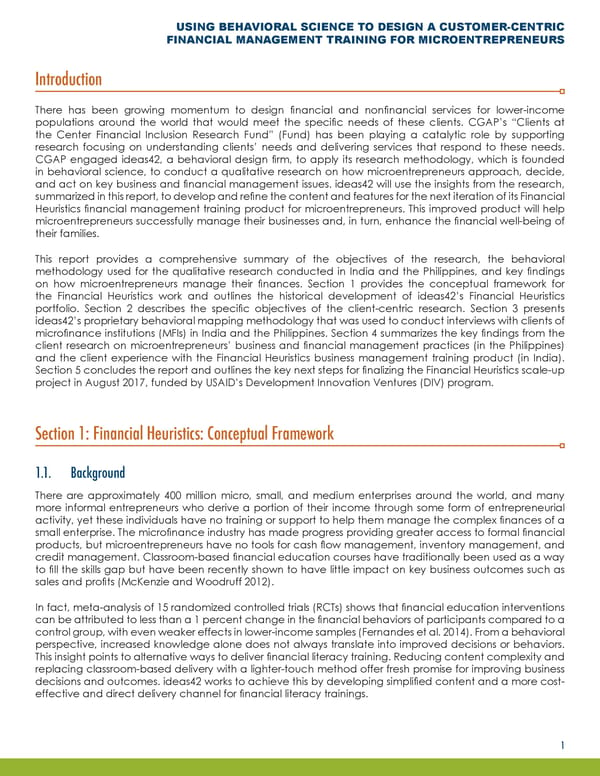USING BEHAVIORAL SCIENCE TO DESIGN A CUSTOMER-CENTRIC FINANCIAL MANAGEMENT TRAINING FOR MICROENTREPRENEURS Introduction There has been growing momentum to design financial and nonfinancial services for lower-income populations around the world that would meet the specific needs of these clients. CGAP’s “Clients at the Center Financial Inclusion Research Fund” (Fund) has been playing a catalytic role by supporting research focusing on understanding clients’ needs and delivering services that respond to these needs. CGAP engaged ideas42, a behavioral design firm, to apply its research methodology, which is founded in behavioral science, to conduct a qualitative research on how microentrepreneurs approach, decide, and act on key business and financial management issues. ideas42 will use the insights from the research, summarized in this report, to develop and refine the content and features for the next iteration of its Financial Heuristics financial management training product for microentrepreneurs. This improved product will help microentrepreneurs successfully manage their businesses and, in turn, enhance the financial well-being of their families. This report provides a comprehensive summary of the objectives of the research, the behavioral methodology used for the qualitative research conducted in India and the Philippines, and key findings on how microentrepreneurs manage their finances. Section 1 provides the conceptual framework for the Financial Heuristics work and outlines the historical development of ideas42’s Financial Heuristics portfolio. Section 2 describes the specific objectives of the client-centric research. Section 3 presents ideas42’s proprietary behavioral mapping methodology that was used to conduct interviews with clients of microfinance institutions (MFIs) in India and the Philippines. Section 4 summarizes the key findings from the client research on microentrepreneurs’ business and financial management practices (in the Philippines) and the client experience with the Financial Heuristics business management training product (in India). Section 5 concludes the report and outlines the key next steps for finalizing the Financial Heuristics scale-up project in August 2017, funded by USAID’s Development Innovation Ventures (DIV) program. Section 1: Financial Heuristics: Conceptual Framework 1.1. Background There are approximately 400 million micro, small, and medium enterprises around the world, and many more informal entrepreneurs who derive a portion of their income through some form of entrepreneurial activity, yet these individuals have no training or support to help them manage the complex finances of a small enterprise. The microfinance industry has made progress providing greater access to formal financial products, but microentrepreneurs have no tools for cash flow management, inventory management, and credit management. Classroom-based financial education courses have traditionally been used as a way to fill the skills gap but have been recently shown to have little impact on key business outcomes such as sales and profits (McKenzie and Woodruff 2012). In fact, meta-analysis of 15 randomized controlled trials (RCTs) shows that financial education interventions can be attributed to less than a 1 percent change in the financial behaviors of participants compared to a control group, with even weaker effects in lower-income samples (Fernandes et al. 2014). From a behavioral perspective, increased knowledge alone does not always translate into improved decisions or behaviors. This insight points to alternative ways to deliver financial literacy training. Reducing content complexity and replacing classroom-based delivery with a lighter-touch method offer fresh promise for improving business decisions and outcomes. ideas42 works to achieve this by developing simplified content and a more cost- effective and direct delivery channel for financial literacy trainings. 1
 Using Behavioral Science to Design a Customer-Centric Financial Management Training for Microentrepreneurs Page 3 Page 5
Using Behavioral Science to Design a Customer-Centric Financial Management Training for Microentrepreneurs Page 3 Page 5